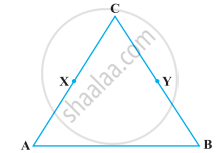Advertisements
Advertisements
प्रश्न
Read the following two statements which are taken as axioms:
- If two lines intersect each other, then the vertically opposite angles are not equal.
- If a ray stands on a line, then the sum of two adjacent angles so formed is equal to 180°.
Is this system of axioms consistent? Justify your answer.
उत्तर
We know that, if two lines intersect each other, then the vertically opposite angles are equal. It is a theorem, So given Statement I is false and not an axiom.
Also, we know that, if a ray stands on a line, then the sum of two adjacent angles so formed is equal to 180°. It is an axiom. So, given Statement II is true and an axiom.
Thus, in given statements, first is false and second is an axiom.
Hence, given system of axioms is not consistent.
APPEARS IN
संबंधित प्रश्न
Give a definition of the following term. Are there other terms that need to be defined first? What are they, and how might you define them?
line segment
Consider two ‘postulates’ given below:-
- Given any two distinct points A and B, there exists a third point C which is in between A and B.
- There exist at least three points that are not on the same line.
Do these postulates contain any undefined terms? Are these postulates consistent? Do they follow from Euclid’s postulates? Explain.
Why is Axiom 5, in the list of Euclid’s axioms, considered a ‘universal truth’? (Note that the question is not about the fifth postulate.)
How many lines can be drawn through a given point.
The number of dimensions, a surface has ______.
Euclid divided his famous treatise “The Elements” into ______.
‘Lines are parallel, if they do not intersect’ is stated in the form of ______.
The edges of a surface are curves.
Solve the following question using appropriate Euclid’s axiom:
In the following figure, we have X and Y are the mid-points of AC and BC and AX = CY. Show that AC = BC.

In the following figure BM = BN, M is the mid-point of AB and N is the mid-point of BC. Show that AB = BC.

